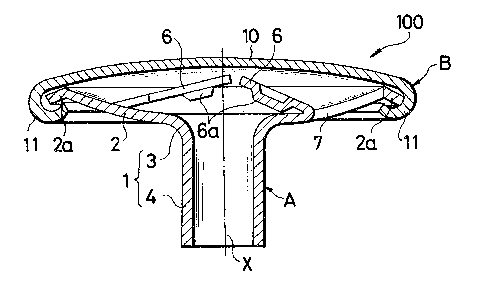Une partie des informations de ce site Web a été fournie par des sources externes. Le gouvernement du Canada n'assume aucune responsabilité concernant la précision, l'actualité ou la fiabilité des informations fournies par les sources externes. Les utilisateurs qui désirent employer cette information devraient consulter directement la source des informations. Le contenu fourni par les sources externes n'est pas assujetti aux exigences sur les langues officielles, la protection des renseignements personnels et l'accessibilité.
L'apparition de différences dans le texte et l'image des Revendications et de l'Abrégé dépend du moment auquel le document est publié. Les textes des Revendications et de l'Abrégé sont affichés :
| (12) Brevet: | (11) CA 1274972 |
|---|---|
| (21) Numéro de la demande: | 1274972 |
| (54) Titre français: | FIXATION A OEILLET BORGNE POUR BOUTON-PRESSION |
| (54) Titre anglais: | CAPPED EYELET FOR ATTACHING SNAP FASTENER |
| Statut: | Durée expirée - après l'octroi |
| (51) Classification internationale des brevets (CIB): |
|
|---|---|
| (72) Inventeurs : |
|
| (73) Titulaires : |
|
| (71) Demandeurs : |
|
| (74) Agent: | GOWLING WLG (CANADA) LLP |
| (74) Co-agent: | |
| (45) Délivré: | 1990-10-09 |
| (22) Date de dépôt: | 1985-10-18 |
| Licence disponible: | S.O. |
| Cédé au domaine public: | S.O. |
| (25) Langue des documents déposés: | Anglais |
| Traité de coopération en matière de brevets (PCT): | Non |
|---|
| (30) Données de priorité de la demande: | ||||||
|---|---|---|---|---|---|---|
|
ABSTRACT OF THE DISCLOSURE
A capped eyelet, for attachment of a snap
fastener member to a garment fabric, comprises an eyelet
body including a shank with a flange, a cap covering over
the flange and secured to a periphery thereof, and at
least one punched buffer wing projecting from the flange
and having at least one rib. The buffer wing is
resiliently deformable to absorb an endwise force applied
to the shank when the eyelet is axially compressed for
being joined with a snap fastener member. At that time
the rib is engageable with the upper end portion of the
shank to assist in absorbing the riveting force. As a
result, the cap is not subject to marking with scars at
its outer surface.
Note : Les revendications sont présentées dans la langue officielle dans laquelle elles ont été soumises.
Note : Les descriptions sont présentées dans la langue officielle dans laquelle elles ont été soumises.

2024-08-01 : Dans le cadre de la transition vers les Brevets de nouvelle génération (BNG), la base de données sur les brevets canadiens (BDBC) contient désormais un Historique d'événement plus détaillé, qui reproduit le Journal des événements de notre nouvelle solution interne.
Veuillez noter que les événements débutant par « Inactive : » se réfèrent à des événements qui ne sont plus utilisés dans notre nouvelle solution interne.
Pour une meilleure compréhension de l'état de la demande ou brevet qui figure sur cette page, la rubrique Mise en garde , et les descriptions de Brevet , Historique d'événement , Taxes périodiques et Historique des paiements devraient être consultées.
| Description | Date |
|---|---|
| Inactive : Périmé (brevet sous l'ancienne loi) date de péremption possible la plus tardive | 2007-10-09 |
| Lettre envoyée | 2001-09-26 |
| Accordé par délivrance | 1990-10-09 |
Il n'y a pas d'historique d'abandonnement
| Type de taxes | Anniversaire | Échéance | Date payée |
|---|---|---|---|
| TM (catégorie 1, 7e anniv.) - générale | 1997-10-09 | 1997-09-11 | |
| TM (catégorie 1, 8e anniv.) - générale | 1998-10-09 | 1998-07-14 | |
| TM (catégorie 1, 9e anniv.) - générale | 1999-10-11 | 1999-07-09 | |
| TM (catégorie 1, 10e anniv.) - générale | 2000-10-09 | 2000-07-14 | |
| Enregistrement d'un document | 2001-09-10 | ||
| TM (catégorie 1, 11e anniv.) - générale | 2001-10-09 | 2001-09-18 | |
| TM (catégorie 1, 12e anniv.) - générale | 2002-10-09 | 2002-09-19 | |
| TM (catégorie 1, 13e anniv.) - générale | 2003-10-09 | 2003-09-17 | |
| TM (catégorie 1, 14e anniv.) - générale | 2004-10-11 | 2004-09-09 | |
| TM (catégorie 1, 15e anniv.) - générale | 2005-10-10 | 2005-09-08 | |
| TM (catégorie 1, 16e anniv.) - générale | 2006-10-09 | 2006-09-08 |
Les titulaires actuels et antérieures au dossier sont affichés en ordre alphabétique.
| Titulaires actuels au dossier |
|---|
| YKK CORPORATION |
| Titulaires antérieures au dossier |
|---|
| AKIRA TANAKA |
| TAKEO FUKUROI |